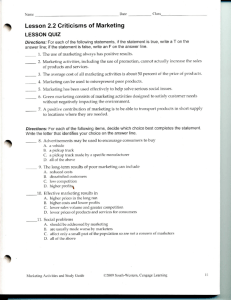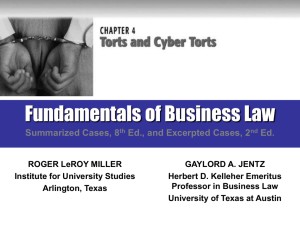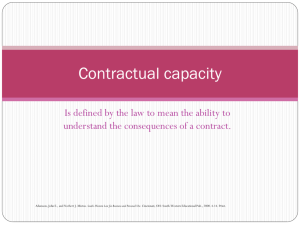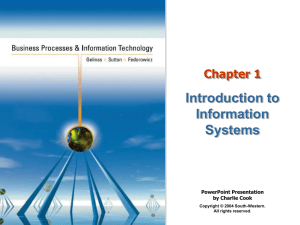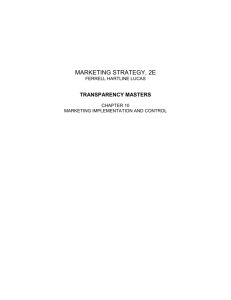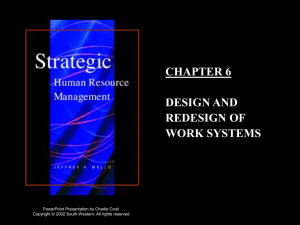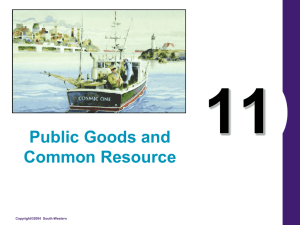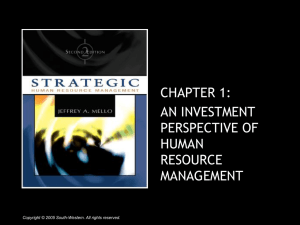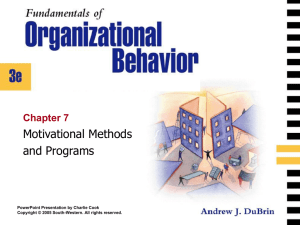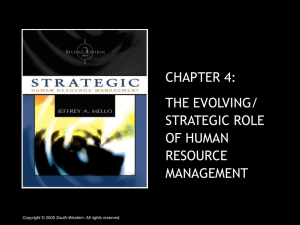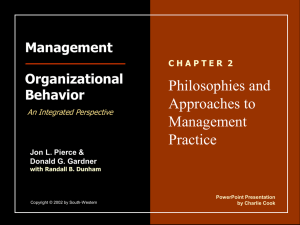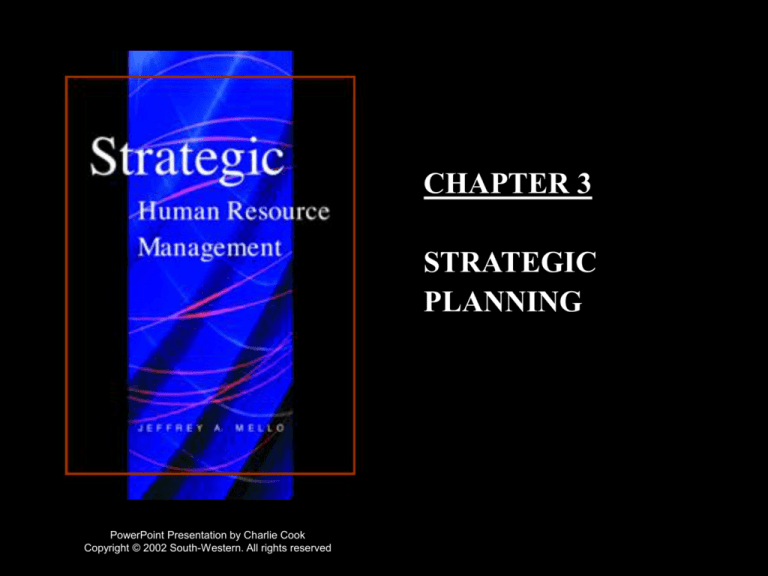
CHAPTER 3
STRATEGIC
PLANNING
PowerPoint Presentation by Charlie Cook
Copyright © 2002 South-Western. All rights reserved
Strategic Management
• Strategic Human Resource Management
– Involves aligning initiatives involving how people are managed
with the organizational mission and objectives.
• Strategic Management Process
– Determining what needs to be done (how) to achieve
corporate objectives over a three- to five year time span.
– Examining the organization and the competitive environment.
– Establishing a strategic (optimal) “fit” between the organization
and its environment that engenders success.
– Reviewing and revising the strategic plan as necessary.
Copyright © 2002 South-Western. All rights reserved.
3–2
Models of Strategy
• Industrial Organization (O/I) Model
– The external environment is the primary determinant of
organizational strategy rather than the internal decisions of its
managers.
– The environment presents threats and opportunities.
– All competing organizations control or have equal access to
resources.
– Resources are highly mobile between firms.
– Organizational success is achieved by offering goods and
services at lower costs than competitors or by differentiating
products such that they bring premium prices.
Copyright © 2002 South-Western. All rights reserved.
3–3
Models of Strategy (cont’d)
• Resource-Based View (RBV)
– An organization’s resources and capabilities, not external
environmental conditions, should be the basis for strategic
decisions.
– Competitive advantage is gained through the acquisition and
value of organizational resources.
– Organizations can identify, locate and acquire key valuable
resources.
– Resources are not highly mobile across organizations and
once acquired are retained.
– Valuable resources are costly to imitate and non-substitutable.
Copyright © 2002 South-Western. All rights reserved.
3–4
Copyright © 2002 South-Western. All rights reserved.
3–5
The Mission Statement
Copyright © 2002 South-Western. All rights reserved.
3–6
Corporate Strategies: Growth
• Benefits
– Gaining economies of scale in
operations and functions
– Enhancing competitive position
vis-à-vis industry competitors
– Providing opportunities for
employee professional
development and advancement
• HR Issues
– Planning for new hiring
– Alerting current employees
– Ensuring quality and
performance standards are
maintained
Copyright © 2002 South-Western. All rights reserved.
• Internal Methods
– Penetration of existing markets
– Developing new markets
– Developing new products or
services for existing or new
markets
• External Methods
– Acquiring other organizations
– Vertical integration
• HR Issues
– Merging organizations
– Dismissing redundant employees
3–7
Corporate Strategies (cont’d)
• Stability
– Maintaining the status quo due to limited environmental
opportunities for gaining competitive advantage.
– Few employees will have opportunities for advancement.
– Critical that management identify key employees and develop
specific HR retention strategies to keep them.
• Turnaround or Retrenchment
– Downsizing or streamlining the organization in a cost-cutting
attempt to adjust to the competitive environment.
– Few opportunities and many environmental threats.
– Important to develop HR practices to manage the “survivors.”
Copyright © 2002 South-Western. All rights reserved.
3–8
Business Unit Strategies: Cost Leadership
• Increases in efficiency and cutting of costs; then
passing the savings to the consumer.
• Assumes price elasticity in demand for products or
services is high; small change in price will cause
large increase in demand.
• Assumes that customers are more price sensitive
than brand loyal.
• HR strategy focuses on short-term performance
measures of results and promoting efficiency
through job specialization and cross-training.
Copyright © 2002 South-Western. All rights reserved.
3–9
Business Unit Strategies: Differentiation
• Attempting to distinguish organizational products
or services from other competitors or creating the
perception of a difference in order to demand a
premium price from consumers.
• Organization offers employees incentives and
compensation for creativity.
• HR strategy focuses on external hiring of unique
individuals and on retaining creative employees.
Copyright © 2002 South-Western. All rights reserved.
3–10
Business Unit Strategies: Focus
• Business attempts to satisfy the needs of only a
particular group or narrow segment of the market.
• Strategic intent is to gain consumer loyalty of
neglected groups of consumers.
• Strategic HR issue is ensuring employee
awareness of uniqueness of market segment.
– Thorough employee training and a focus on customer
satisfaction are critical factors.
– Hiring members of the target segment who are empathetic to
customer in the target segment.
Copyright © 2002 South-Western. All rights reserved.
3–11
Business Unit Strategies: Logics of Control
Copyright © 2002 South-Western. All rights reserved.
3–12
Business Unit Strategies: Logics of Control (cont’d)
EXHIBIT 3-3: DYER AND HOLDER’S TYPOLOGY OF STRATEGIES (cont’d)
Copyright © 2002 South-Western. All rights reserved.
3–13
Benefits of a Strategic Approach to HR
• Facilitates the development of a high-quality
workforce through its focus on the types of people
and skills needed.
• Facilitates cost-effective utilization of labor,
particularly in service industries where labor is
generally the greatest cost.
• Facilitates the planning and assessment of
environmental uncertainty and the adaptation of
the organization to the external forces that impact
the organization.
Copyright © 2002 South-Western. All rights reserved.
3–14
Reading 3.2: The Five P’s Model of SHRM
• Philosophy
– Statements of how the organization values and treats
employees; essentially the culture of the organization.
• Policies
– Expressions of shared values and guidelines for action on
employee-related business issues.
• Programs
– Coordinated and strategized approaches to initiate,
disseminate, and sustain strategic organizational change
efforts necessitated by strategic business needs.
Copyright © 2002 South-Western. All rights reserved.
3–15
Reading 3.2: The Five P’s Model of SHRM
• Practices
– HR practices that motivate behaviors that allow individuals to
assume roles consistent with the organization’s strategic
objectives.
• Processes
– The continuum of participation by all employees in the specific
activities of to facilitate the formulation and implementation of
other activities.
Copyright © 2002 South-Western. All rights reserved.
3–16
Reading 3.2: Implications of SHRM
• Successful SHRM efforts begin with identification
of strategic needs.
• Employee participation is critical to linking
strategy and HR practices.
• Strategic HR depends on a systematic and
analytical mindset.
• Corporate HR departments can have an impact on
their organization’s efforts to launch strategic
initiatives.
Copyright © 2002 South-Western. All rights reserved.
3–17


